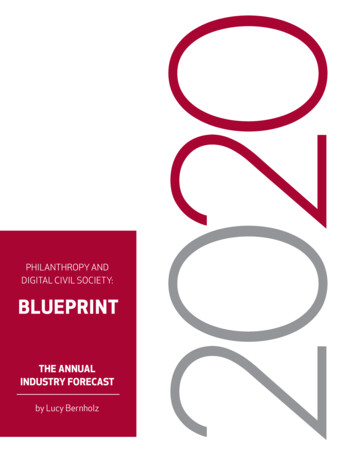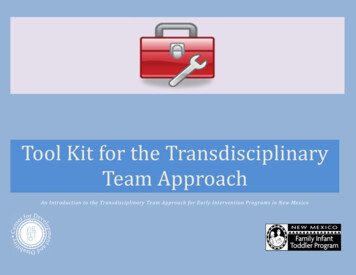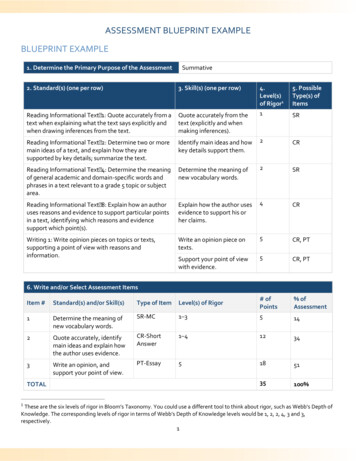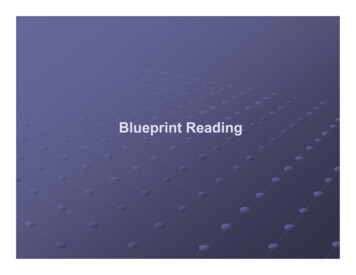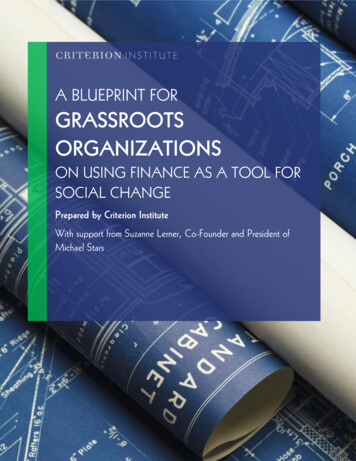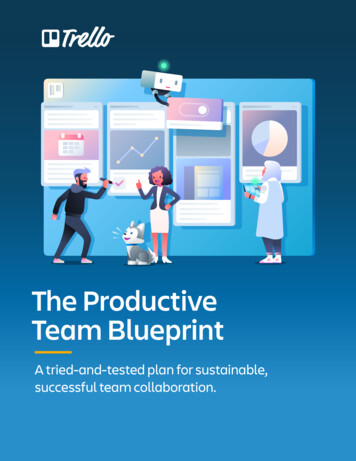
Transcription
The ProductiveTeam BlueprintA tried-and-tested plan for sustainable,successful team collaboration.
Contents3Introduction4Team Communication5Team Talk Basics6Who8When10Where12Plans & Status Report13Effective Meetings : #NoSnoozeFeeds14The 4 Essentials Elements of Effective Meetings15Set Up Secure Collaboration18Team Direction19Get Team Goals Together20Tracking As A Team23Team Evolution24Retrospectives25Making Changes26Building Your Team’s Blueprint27Essential Power-Ups and Integrations For YourTeam29Enterprise Page
IntroductionAt Trello, we don’t take successful teamcollaboration for granted. With 1 in 3 teammembers working remotely from locations allover the world, exceptional teamwork has tobe the core of our company work culture.Over the years, we’ve curated hard-won lessons from ourday-to-day experiences working in distributed teams andinvaluable advice from leading productivity experts. The result?All of our best resources for how teams can work better togetherin one handy ebook.Productive team collaboration can be broken down into four irectionEvolutionBy having these four mechanisms running together likea well-oiled machine, your team will be more productive thanever before. So whether your team is distributed across multiplelocations or sitting all together in an open concept office, thisblueprint will give you the resources and tools you need to builda solid foundation for your team’s future success. Ready to getstarted?Let’s Go!3
Team CommunicationEffective communication is what binds strongteams together. Before we look at how to buildgood team talk, it’s important to recognize whathappens when team members aren’t talking.It happens to the best of us—communication within your team isfragmented which creates a “silo effect” where each individual isworking furiously on their list of to-do’s without a full perspective oftheir team’s big picture impact. No one knows who’s responsible forwhat and it’s difficult to find information when you need it to get yourjob done.This silo effect creates situations in which teammates repeat oneanother’s work or have conflicting projects. Basically, everyone is out oftouch with what’s actually going on and constant check-ins to get onthe same page delay the entire team from reaching project milestones.Fragmented communication and lack of communication are the twoingredients that lead to poor team communication and dwindlingproductivity levels.The Dangers of the Silo Effect Transparency is nonexistentCollaboration goes out the windowRedundancies are on repeatTimelines aren’t metExpectations are wrongIf your team is struggling to communicate effectively, it may be timeto set up some team talk basics.4
Team Talk BasicsInterruptions are an ultimate productivity killer. Studies show thatwhen a person is interrupted from deep work, it can take them aslong as 25 minutes to get back into the zone. 25 minutes. That’s alot!Team talk basics are about knowing what typesof communicators are in your team, when it’s bestto initiate communication with them, and how tobest do so.Interruptions will always happen. Questions have to be askedand answered in order to increase productivity, after all.But the truth is there are good ways to do this and there are badways. It’s essential to define collaborative team talk guidelinesto enable authenticity and bonding while also knowing how tomake the most of team communication assets, The Who, When,and Where, in order to encourage productive discussions whileminimizing distractions.5
WhoTo establish great team communication, we first have to talk aboutwho is doing the talking.Paul Graham, a renowned computer scientist and cofounder of YCombinator, established a concept called the Maker vs. Manager.The difference between the two affects how a team should becommunicating. The first type of team member is the maker: Makersare people like developers, designers, and writers.Makers need long, uninterrupted time to go headsdown and create work without any distractions.Managers, on the other hand, are people who coordinate across teams,move teams towards goals, and manage projects.Managers need effective meetings and good,consistent systems for getting status updates.6
While the Manager vs. Maker concept is prettyeasy to understand, it isn’t always clearly definedin organizations.However, understanding who the makers and managers are candramatically improve everyone’s productivity because it helps establishthe needs of different roles. Have team members determine whetherthey are:·· A maker·· A manager·· A combination of bothAnd then assess whether their current schedules and workenvironments are optimized for their role.When working together effectively, makers and managers form theperfect team balance because both roles ensures everything gets donewell and deadlines are being met.7
WhenIn order for the Maker vs. Manager roles to actually work, it’s essentialfor team members to map out when they are heads down in creativework or tied up in meetings.When Makers Are In The Zone It’s important for Makers to block out chunks of their daily schedule oreven an entire day to focus on deep work. Interruptions will preventMakers from being their most productive selves. It is important thatMakers have the respect and authority to set their own boundaries fordevelopment time.TRELLO TEAM TIPif you’re a Maker, try blocking out a recurring “No MeetingDay” on your calendar for deep work. Establish expectationsabout your creative needs, but also communicate with yourteam. Let them know how long you’ll be offline and whenthey can expect you to return.8
When Managers Are In The Zone Makers also need structured schedules to alert their team when they’reavailable for meetings or when they need time to focus on clearingroadblocks for the team’s Makers. Makers are at their peak productivitywhen they set time when they are available on chat apps and emailsand when they don’t have to chase down Makers for regular updates.Systems are in place for access to approvals, answers, and guidance.Agendas, tasks, and plans are clear and defined. Win win! Makers havethe respect and authority to set their own boundaries for developmenttime.TRELLO TEAM TIPif you’re a Maker, try blocking out a recurring “No MeetingDay” on your calendar for deep work. Establish expectationsabout your creative needs, but also communicate with yourteam. Let them know how long you’ll be offline and whenthey can expect you to return.Learn More AboutManaging With Makers9
WhereNext, using the correct methods and tools in the right context will helpyou establish guidelines for “where” your team should communicatewith each other.Quick Pings and UpdatesMakers also need structured schedules to alert their team whenthey’re If you’re co-located in an office, it can be tempting to use quickquestions as an excuse to stretch your legs. However, it might be moreeffective to take regular walks around the block for exercise and rely ona chat app for short messages instead.Chat apps are a great way to enable quick communication amongyour teammates and it leaves a digital paper trail—especially if it’ssomething your whole team should be aware of.TRELLO TEAM TIPIf you’re not on a chat app like Hipchat or Slack, get one.While email is still a necessary workplace communicationtool, it should be reserved for longer, more static,conversation.Learn More AboutChat App Etiquette10
Deeper DiscussionIf you work remotely or aren’t co-located with all of your teammates,establishing which communication methods to use for deeperdiscussions is vital. This also applies to in-office for knowing when agroup meeting is necessary (or just a waste of time).Chat apps are transformative for teams that aren’t already using them,but they aren’t as great for getting into in depth debates. Instead, anytime your team is having a discussion that requires more thought andplanning than a quick question, move to a meeting.TRELLO TEAM TIPIf you’re not on a chat app like Hipchat or Slack, get one.While email is still a necessary workplace communicationtool, it should be reserved for longer, more static,conversation.Check Out The BoardLearn More About VideoMeeting EtiquetteStay Connected To All The Moving PartsWith Trello Enterprise, you can easily keep tabs on all the activityand chatter happening across Trello boards with Highlights. WithHighlights, you can understand who people are, what they’re workingon, and what’s going on in any given moment with tasks and projects.This allows you and your teammates to quickly identify gaps and newopportunities.When there’s a lot going on, it’s easy for things to go a little haywire.Trello Enterprise has another feature to save time and keep thingsorganized: Collections. Collections is a way to group related boardsso you can quickly see all the projects associated with a particulardepartment or broader initiative.11
Plans & Status ReportsWhenever your team needs to document the status of projects indigestible, accessible formats, don’t put all of this information in anemail or chat app where information quickly gets buried and archived.In order to be productive, you team needs information and resourcesaccessible to their digital fingertips as quickly as possible.Instead of relying on chat apps or email, use a team collaborationplatform to:········Manage projectsDocument status reportsPlan meeting agendasOrganize key informationThe platform should be asynchronous, meaning that any teammatecan hop in and easily locate what they need, when they need it.TRELLO TEAM TIPTrello gives your whole company a shared perspective onprojects, plans, and everything in between: Tasks, progress,questions, materials, due dates, and more for any team orproject. With Trello boards, the sky’s the limit for how you canstructure your team communication.Check Out The Board12
Effective Meetings:#NoSnoozeFestsChat apps, email, and productivity tools like Trello aren’t enough.Meetings are the cornerstone for setting up these lines ofcommunication—if they are truly effective.There’s nothing worse than a boring, overly long meeting (that could’vebeen an email update).From the perspective of your bottom line, having multiple people you’repaying in an hour-long meeting is expensive as it is. Any time a groupof people is zoning out or distracted because the time isn’t structured,your team’s productivity drags.Avoid time-wasting snooze fests by sticking to a specific structure andmaking other, intentional opportunities for off-topic conversations.TRELLO TEAM TIPUse a Trello list for your team meeeting agenda. Teammembers can add agenda items as cards to the list and logmeeting notes on the card. Post-meeting, assign the agendacards needing follow-up as tasks to the designated teammember and project board!13
The 4 Essential Elements ofEffective MeetingsAn agendaEvery meeting should have an agenda to avoid misused time and tokeep meetings productive. That said, every agenda should involve ademocratic process where each team member can submit items to bediscussed prior to the meeting to ensure that everyone’s voice is beingheard.A meeting leadTo organize meetings most efficiently, all meetings should have adesignated lead who sets the final agenda, runs a timer to make sureall agenda items stay within their allotted time, and mediates off-topicconversations.A scribeWhether some meetings have a conflicting meeting, or you haveteam members out on vacation, make sure to designate someone totake notes during the meeting so everyone on the team knows whathappened and can follow up.A plan of action for discussed itemsMeetings are pointless unless agenda items discussed have a result.Make sure your meeting lead or scribe follows up on all action items toensure someone is taking responsibility for seeing them through. Followup can be as simple as a summary of to-do’s sent via chat app.How To Finally EndTime-Wasting Meetings14
Set Up Secure CollaborationWhen your team is tapping into their most productive hours andtruly moving the needle within your organization, they shouldn’t beconcerned with security, data breaches, and compromising intellectualproperty.Without secure collaboration and systems in place, your team will bemore focused on what they can or can’t do than actually getting thework done. Cue productivity nightmare.Secure access is one of the biggest threats to companies today.Gartner predicts that about 30% of corporate data traffic will bypassregular security measures and flow directly from mobile and portabledevices to the cloud.Information is not only your company’s most important asset but alsoone of your largest, potential liabilities. It’s incredibly important, anddifficult, to ensure that you have the right internal controls in place toensure the security of your company data.And to top it off, if you don’t have clear guidelines in regards to whichtools employees should use and how they should use them, you haveyou have no way to ensure that they’re not compromising sensitivecompany information.15
Best-In-Class SecurityWhen it comes to your collaboration platform and tools, look for thesefeatures to proactively keep your company safe. Here are the topsecurity features in Trello Enterprise:·· SSO Sign-On: Your team can sign on with a single click (and avoidsecurity headaches) thanks to available Single Sign-On for all SAMLIdPs.·· Permission Restrictions: Set access restrictions at both the teamand board levels. Specify who can create public, team-visible, andprivate boards—as well as who can be added to each—and ensurethat your teams can collaborate easily, while still keeping sensitivework private.·· Attachment Restrictions: Prevent file sharing chaos by locking inyour preferred file sharing systems: Only approved file share linkscan be included on Trello cards.·· Phone and Priority Email Support: Have a question or concern?Jump to the front of the line and chat with our Trello experts viaphone or email.16
Team DirectionHaving a defined direction for your teamworklays the foundation for maintaining consistentproductivity as a team.When a triathlon starts with the swim leg of the race, all theathletes rush into the water at once, stirring up sand and sedimentuntil the ocean is a messy, brown version of its former clear self.Wading into the waters of goal setting as a team often feels thesame way—rushed and murky.The entire point of establishing clear objectives is to clear the wayand identify markers of success that build purpose and plan forwhat work matters most. They should serve to motivate and focusteam efforts so distractions are kept to a minimum and everyonecan be allowed to contribute at their best.We believe setting team goals start with three fundamental factsabout how a team approaches setting goals together:1. Make it collaborative.2. Make it easy to update.3. Make it your own.If you’re not already defining, setting,and tracking your team goals and metrics,it’s time to start.18
Get Team Goals TogetherIn most organizations, there’s one ultimate goal that’s broken upinto several smaller goals for individual teams to focus on.A company might have a production team, a sales team, anda management team. Together, the teams work together togenerate revenue for the business. But to do that, each team hastheir separate goals of making the product, selling the product,and enabling the employees at the company to get the job done.You can see why organizations tend to be structured how they are.In your own organization, it’s important to make sure that yourteam’s goals are aligned with the company’s overall goals andwith the goals of other connected teams. A holistic view of eachdepartment’s goals and activities brings more visibility into thesetypically disjointed channels.Having a shared place where you track goals is a great wayto create cross-team collaboration. At Trello, we do this witha Company Overview board:·· Lists are organized by high-level company goals·· Each team organizes their top goals and projects as cards in theappropriate list·· Cards include context and links to project boards, stakeholders,and more·· Weekly progress updates are posted on each cardEvery team member can then see goals, project status, and more.Bonus points for linking your card updates to your chat app forautomatic circulation into your team’s group chatroom!19
Tracking As A TeamOnce your team goals are set and organized, make sure you create a wayto track progress as a team. It’s easiest to follow a standard framework,and then tweak it to suit your team’s needs.Let’s use the OKR (Objectives and Key Results) framework popularized byIntel and Google as an example.For every objective (or goal) we set, we determine a list of key results (oractions) that we can take to reach that goal. OKRs are generally plottedover a company’s quarter time. That’s three months, or 90 days, if you’recounting—so be ambitious, but also realistic!Don’t expect to reach all of your OKRs. If you do, they’re not hard enough!You should expect to score at approximately 70% of your objectives andkey results. However, OKRs are most successful when:20
·· They are co-created with other teams in the company on whichyou rely for materials or help. These are known as “Dependencies.”·· They are checked against the top-level company goals and arejustified to fit.The key results are SMART goals. In other words, they are specific,measurable, action-oriented, realistic, and time-based within thequarterly time frame.Once we set our OKRs, we record them all on Trello cards, where wecan indicate which actions are in progress, blocked, or completedthroughout the quarter. We even assign team members to actionsso everyone has a clear (and balanced) list of projects to work onover the next 90 days.It may seem like a lot of structure, but essentially OKRs become aco-created team to-do list that can be plotted over a 90-day workperiod. You can be confident as a team that you’ll make a positiveimpact on the company. Doesn’t that sound nice?21
Team EvolutionAs with all things worth reaching for, settingteam goals is only half the battle. For yourteam to be effective, you have to track yourperformance against those goals over time.Enter: the retrospective.If you’re going to set goals as a team, you’re also going to want toreview the results as a team.Good teams evolve into better teams when they make an effort tovalue the processes and dynamics that work well, and to discussand change the ones that don’t.Take the time to look back, to celebrate the wins and learn from themisses. It just might make the difference for your team!23
RetrospectivesRetrospectives are dedicated meetings where teammates discussthe good, the bad, and the ugly post-project or at the end of thequarter’s OKRs. Retrospective exercises are healthy for teamproductivity because they encourage honesty with the intent toimprove.Here are five ideas for creating room on yourteam for productive retrospectives:1Take a quick temperature gaugewith your team once a month.Ask people to draw out (orassign an emoji) as a “weather”report of how they think theteam is working together. Getcreative with it! Try using asurvey software like Typeformor SurveyMonkey if anonymity isappropriate.3Ask for open-ended feedbackfrom teammates. When you doso, look for common themes orinsights. For example, did threeout of five people talk aboutcommunication preferences?That insight might be somethingto pay attention to.5View the data: If you havequantitative goals set for yourteam, this should be relativelystraightforward. Once a month,create a document or reportthat goes through the metricsyour team has set. Don’t justtrack whether or not goals werehit. Instead, encourage teammembers to answer the “why orwhy not” questions.24Decide what to do: What doyou all agree to try differentlyor keep doing the samenext time? Try using pollingsoftware, like TINYPulse, if anew process or project needsto be put up to vote.Have some fun! Celebrate teamwins and find fun ways to let offsome steam before you gear upagain for the next set of goals. Ifyou just finished the worst projectever, it’s OK to bond over thestruggle so long as you cap it offand clear the plate at the end ofthe bash sesh.24
Making ChangesYour team’s communication and direction will inevitably changeover time. Rather than try to force the same processes to workforever and a day, think about how and when you can innovate yourteamwork through new experiences, technology, or structure.Ultimately, making regular updates to fit the needs of your teamwill make all team members more productive.Whether you’re a team manager or a maker, every team membershould have a stake in holding the team accountable forimprovements over time. In fact, research shows that the mostproductive teams hold themselves accountable rather than relyingon a manager to set the pace.Here are a few Trello Team tips for regularlyevaluating your teamwork:1Write down your team process. Asyour team grows, it will be helpfulfor new teammates to have aplace they can go to understandcurrent team processes. Jotdown notes in a document oruse a Trello Board to structureyour team’s resources. Havingprocesses in writing makes iteasier to evaluate how the idealdiffers from reality3Uphold the right to call for aretrospective. When things feeloff or more clunky than necessary,give each team member theright to call the team togetherto evaluate and discuss what isworking well and what is not.Fresh eyes are valuable.Encourage all new teammembers to give insight intohow well processes work as theylearn to adjust to the new team.Give room for team members togive new suggestions for makinga process work better for yourteam.24Give credit where credit is due.Any time a team member has asuggestion for a new process,encourage that team memberto take the lead on establishingthe process for the rest of theteam. Their enthusiasm is whatchange is all about.25
Building Your Team’s BlueprintYour team’s productivity blueprint is unique, dynamic, and most ofall, exciting! It just feels good to work day-in, day-out with a groupof people who feel engaged and inspired when collaborating andcommunicating with each other.There are many things to remember when planning for your team’scommunication, direction, and evolution:·· Know your team members’ roles and what they need from theteam to be productive.·· Keep communication clear with the right tools, the right times,and the right types of meetings.·· Collaborate securely so your team has the freedom to workwithout fear of compromising important data or information.·· Set clear goals and keep everyone accountable with OKRtracking.·· Review processes on a regular basis, and don’t be afraid to makechanges.·· Bring all your work into one view with a collaborative platformso your team has instant access to everything they need to dobetter, faster, and more informed work.Most of all, empower everyone to take ownership of the team asa living, breathing entity and encourage it to thrive. Sustainable,successful team collaboration is, after all, the key to your company’ssuccess.26
Essential Power-Ups andIntegrations For Your TeamTrello Enterprise integrates with the tools your team already lovesto use.SLACKNo matter where your sales team is working, the SlackPower-Up for Trello makes it simple to keep your communicationand collaboration apps connected so that no important dealupdates or activities fall through the cracks.CALENDARWhether you are planning a conference or managing an editorialcalendar, the Calendar Power-Up let’s you display cards with duedates in a weekly or monthly calendar view.TEAMGANTTThe TeamGantt Power-Up gives you the ability to view your cards ina beautiful timeline. You can Organize cards from multiple boardsinto a single, beautiful gantt chart inside Trello.GOOGLE DRIVEThe Google Drive Power-Up for Trello brings your files and foldersto Trello cards. Search Google Drive right from Trello and attachrelevant files and folders.DROPBOXThe Dropbox Power-Up for Trello brings your files and folders toTrello cards. The file picker lets you search Dropbox right from Trelloand attach relevant files and folders. See real-time details and livepreviews, with links to take you right to Dropbox.27
ONEDRIVEThe OneDrive Power-Up lets you navigate OneDrive right from Trelloto attach relevant files. Copy and paste links to OneDrive foldersonto Trello cards to attach folders. See previews and latest details,with links taking you directly to OneDrive to work on documentsand access files.ZAPIERAutomate repetitive tasks so you can focus on your most importantwork. The Zapier Power-Up allows you to Set up time-savingautomations in a few clicks to move info and get things donebetween all your favorite apps.28
Check Out The BoardUpgrade Your TeamCreate a central productivity hub for all of your team’sprojects—accessible from any device, anywhere. With TrelloEnterprise, your team can easily navigate users, security,and privacy settings through a single dashboard.Trello Enterprise is flexible enough for all teams to build productive,customized workflows that encourage collaboration.····Everything you love about what’s free in TrelloUnlimited Power-Ups and 100 app integrations to efficientlyleverage all your teams’ top tools.Advanced security such as hourly data backups, data encryption,and Single Sign-On (SSO).Enterprise-wide permissions to control who can do what withinyour Trello boards29
the same page delay the entire team from reaching project milestones. Fragmented communication and lack of communication are the two ingredients that lead to poor team communication and dwindling productivity levels. Team Communication Effective communication is what binds strong teams together. Before we look at how to build



